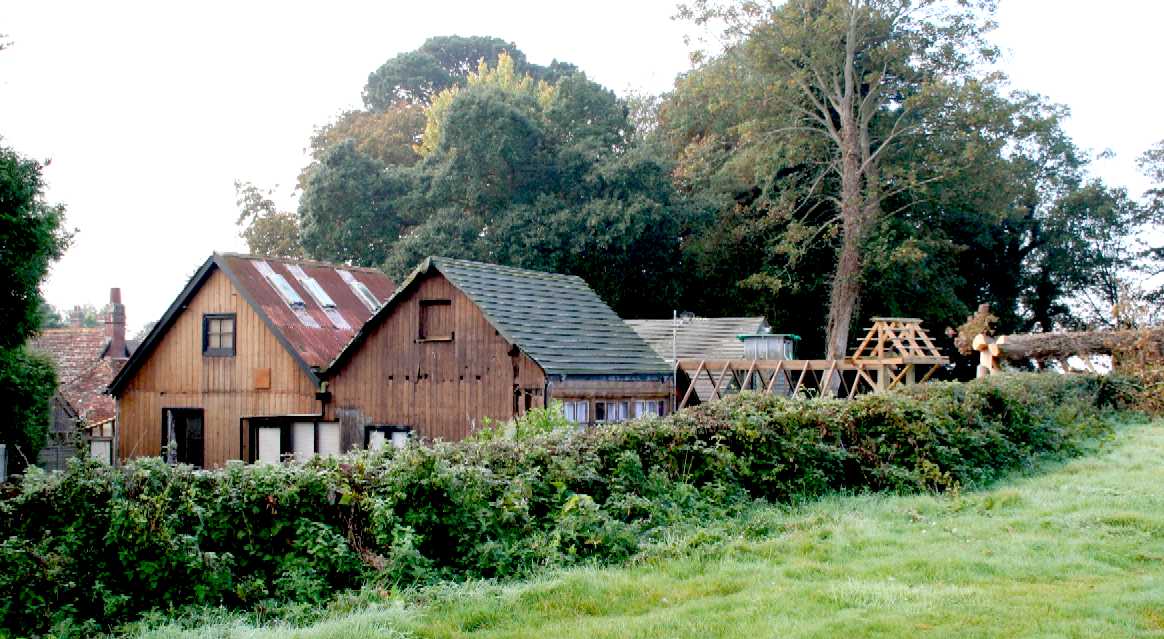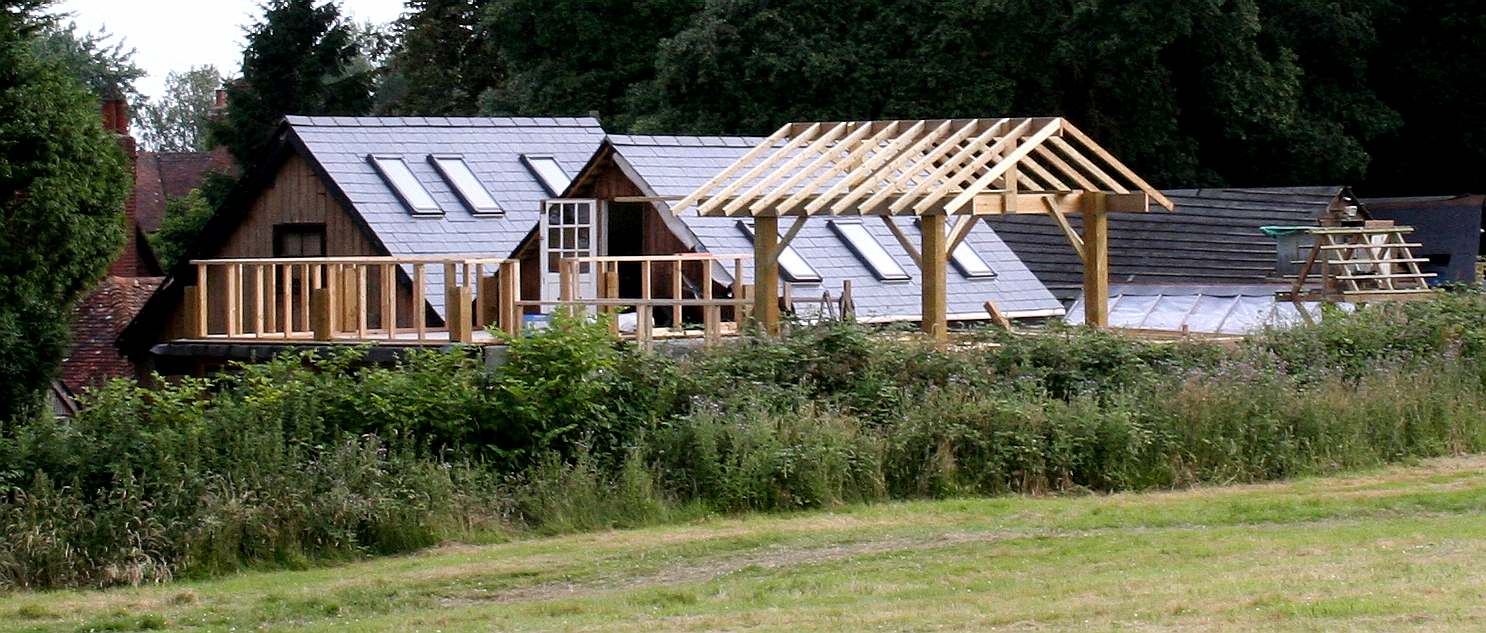
LOW
VOLTAGE SYSTEM - Archaeologically,
the old Generating Works in Lime
Park, is an important surviving example of a
48-56 volt system of public supply, the building and complex (bunkers,
wells, water storage, faggot store) remaining
largely unscathed, with ongoing restoration works. This is in contrast
to the latest high voltage technology that is ousting Alternating
Current systems.
High voltage is used for electric power transmission to reduce the energy lost in the resistance of the wires. For a given quantity of power transmitted, doubling the voltage will deliver the same power at only half the current. Since the power lost as heat in the wires is directly proportional to the square of the current, doubling the voltage reduces the line losses by a factor of 4. While power lost in transmission can also be reduced by increasing the conductor size,
though larger conductors are heavier and more expensive.
High voltage cannot readily be used for lighting or electric motors, so transmission-level voltages must be reduced for end-use equipment. Transformers are used to change the voltage levels in alternating current (AC) transmission circuits. Transformers made voltage changes practical, and AC generators were more efficient than those using DC. These advantages led to early low voltage DC transmission systems being supplanted by AC systems around the turn of the 20th century.
Practical conversion of power between AC and DC became possible with the development of power electronics devices such as mercury-arc valves and, starting in the 1970s, semiconductor devices as thyristors, integrated gate-commutated thyristors (IGCTs), MOS-controlled thyristors (MCTs) and insulated-gate bipolar transistors (IGBT).
But let's not get too technical.
In
days gone by there was a huge technological battle, where advocates of
DC transmission, and AC distribution battled it out for supremacy. In
the early years Alternating Current won out, where the measure of
success was the distance that power could be supplied, without undue
voltage drop.
Electrical
engineers from all over the world conducted experiments and studies as
to installation costs, with the aim of providing electricity to
customers cheaper and more reliably.
In
Lime
Park, just a few hundred yards outside the village
or Herstmonceux, Charles de Roemer, wrestled with this problem.
Should he go for an AC system, or a DC system. In Alternating Current
systems the generating machinery was generally heavier and more
expensive in his day. Not so today, with almost every car being equipped
with an alternator.
Being
a practical problem solver, Charles opted for a DC system, for his Generating
Station, powered by a
36 horsepower National gas engine, and a coal conversion system, to make
the gas to feed the internal combustion machine.
Even
so, this installation involved considerable investment, in building an
underground condensation, or cooling chamber, coal
bunker and outbuildings for the storage of firewood.
ENTER
HIGH VOLTAGE DC
A high-voltage, direct current (HVDC) electric power transmission system (also called a power superhighway or an electrical superhighway) uses direct current (DC) for the transmission of electrical power, in contrast with the more common alternating current (AC) systems.
Most HVDC links use voltages between 100 kV and 800 kV. However, a 1,100 kV link in China was completed in 2019 over a distance of 3,300 km (2,100 mi) with a power capacity of 12 GW. With this dimension, intercontinental connections become possible which could help to deal with the fluctuations of
wind power and
photovoltaics.
HVDC allows power transmission between AC transmission systems that are not synchronized. Since the power flow through an HVDC link can be controlled independently of the phase angle between source and load, it can stabilize a network against disturbances due to rapid changes in power. HVDC also allows transfer of power between grid systems running at different frequencies, such as 50 Hz and 60 Hz. This improves the stability and economy of each
grid, by allowing exchange of power between incompatible networks.
The modern form of HVDC transmission uses technology developed extensively in the 1930s in Sweden (ASEA) and in Germany. Early commercial installations included one in the Soviet Union in 1951 between Moscow and Kashira, and a 100 kV, 20 MW system between Gotland and mainland Sweden in 1954. Before the Chinese project of 2019, the longest HVDC link in the world was the Rio Madeira link in Brazil, which consists of two bipoles of ±600 kV, 3150 MW each, connecting Porto Velho in the state of Rondônia to the São Paulo area with a length of more than 2,500 km (1,600 mi).
ADVANTAGES
A long-distance, point-to-point HVDC transmission scheme generally has lower overall investment cost and lower losses than an equivalent AC transmission scheme. HVDC conversion equipment at the terminal stations is costly, but the total DC transmission-line costs over long distances are lower than for an AC line of the same distance. HVDC requires less conductor per unit distance than an AC line, as there is no need to support three phases and there is no skin effect.
Depending on voltage level and construction details, HVDC transmission losses are quoted at 3.5% per 1,000 km, about 50% less than AC (6.7%) lines at the same voltage. This is because direct current transfers only active power and thus causes lower losses than alternating current, which transfers both active and reactive power.
HVDC transmission may also be selected for other technical benefits. HVDC can transfer power between separate AC networks. HVDC powerflow between separate AC systems can be automatically controlled to support either network during transient conditions, but without the risk that a major power-system collapse in one network will lead to a collapse in the second. HVDC improves on system controllability, with at least one HVDC link embedded in an AC
grid - in the deregulated environment, the controllability feature is particularly useful where control of
energy trading is needed.
The combined economic and technical benefits of HVDC transmission can make it a suitable choice for connecting
electricity sources that are located far away from the main users.
Specific applications where HVDC transmission technology provides benefits include:
- Undersea-cable transmission schemes (e.g. the 720 km North Sea Link, the 580 km NorNed cable between Norway and the Netherlands, Italy's 420 km SAPEI cable between Sardinia and the mainland, the 290 km Basslink between the Australian mainland and Tasmania, and the 250 km Baltic Cable between Sweden and Germany).
- Endpoint-to-endpoint long-haul bulk power transmission without intermediate 'taps,' usually to connect a remote generating plant to the main grid, for example the Nelson River DC Transmission System in Canada.
- Increasing the capacity of an existing power grid in situations where additional wires are difficult or expensive to install.
- Power transmission and stabilization between unsynchronized AC networks, with the extreme example being an ability to transfer power between countries that use AC at different frequencies. Since such transfer can occur in either direction, it increases the stability of both networks by allowing them to draw on each other in emergencies and failures.
- Stabilizing a predominantly AC power grid, without increasing fault levels (prospective short-circuit current).
- Integration of renewable resources such as wind into the main transmission grid. HVDC overhead lines for onshore wind integration projects and HVDC cables for offshore projects have been proposed in North America and Europe for both technical and economic reasons. DC grids with multiple voltage-source converters (VSCs) are one of the technical solutions for pooling offshore wind energy and transmitting it to load centers located far away onshore.
DISADVANTAGES
The disadvantages of HVDC are in conversion, switching, control, availability, and maintenance.
HVDC is less reliable and has lower availability than alternating current (AC) systems, mainly due to the extra conversion equipment. Single-pole systems have availability of about 98.5%, with about a third of the downtime unscheduled due to faults. Fault-tolerant bipole systems provide high availability for 50% of the link capacity, but availability of the full capacity is about 97% to 98%.
The required converter stations are expensive and have limited overload capacity. At smaller transmission distances, the losses in the converter stations may be bigger than in an AC transmission line for the same distance. The cost of the converters may not be offset by reductions in line construction cost and lower line loss.
Operating an HVDC scheme requires many spare parts to be kept, often exclusively for one system, as HVDC systems are less standardized than AC systems and technology changes more quickly.
In contrast to AC systems, realizing multi-terminal systems is complex (especially with line commutated converters), as is expanding existing schemes to multi-terminal systems. Controlling power flow in a multi-terminal DC system requires good communication between all the terminals; power flow must be actively regulated by the converter control system instead of relying on the inherent impedance and phase angle properties of an AC transmission line.
Multi-terminal systems are rare. As of 2012 only two are in service: the Hydro Québec – New England transmission between Radisson, Sandy Pond, and Nicolet and the Sardinia–mainland Italy link which was modified in 1989 to also provide power to the island of Corsica.

POTENTIAL
FUTURE UNESCO
CONTENDER - Archaeologically,
the old Generating Works in Lime Park, is the most important building in
the village, since the Truggery was flattened to make way for some very
ordinary houses. Such is the imagination of local officials. The highly
regarded Castle
and Observatory are not in the village Herstmonceux (despite the name),
being the east side of Windmill Hill and an important location in its
own right.
Saved from collapse in 1981, in this unassuming
complex, the new age of electricity began with wealthy landowners
flexing their wallets - the only people who could afford Thomas
Edison's 'EdiSwan' light bulbs. For in order to have electricity to run the new
fangled lighting, you needed your own generator - and that was noisy,
offsetting the advantage of gas lamps and candles that frequently blew
out with gusts of wind. Silence was then and is now highly valued. Only the very
few could also afford batteries to store power. But in Herstmonceux,
they had a massive energy store, with a whole unit full of giant lead plate
batteries on shelves, crammed to ceiling height with huge glass cases
filled with gallons of sulfuric acid. This is the very first
distribution load-levelling
arrangement, and the only example surviving anywhere in the world, of a
massive battery store. It is quite simply unique. See
ESCC SMR. Or visit at TheKeep in Lewes, or online.

LINKS
& REFERENCE
https://www




